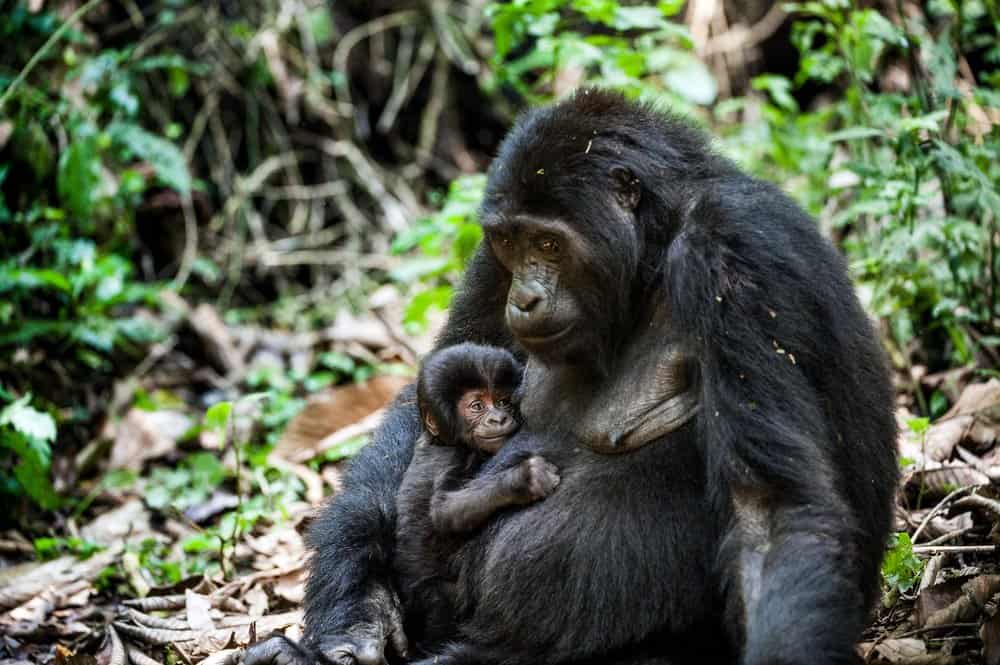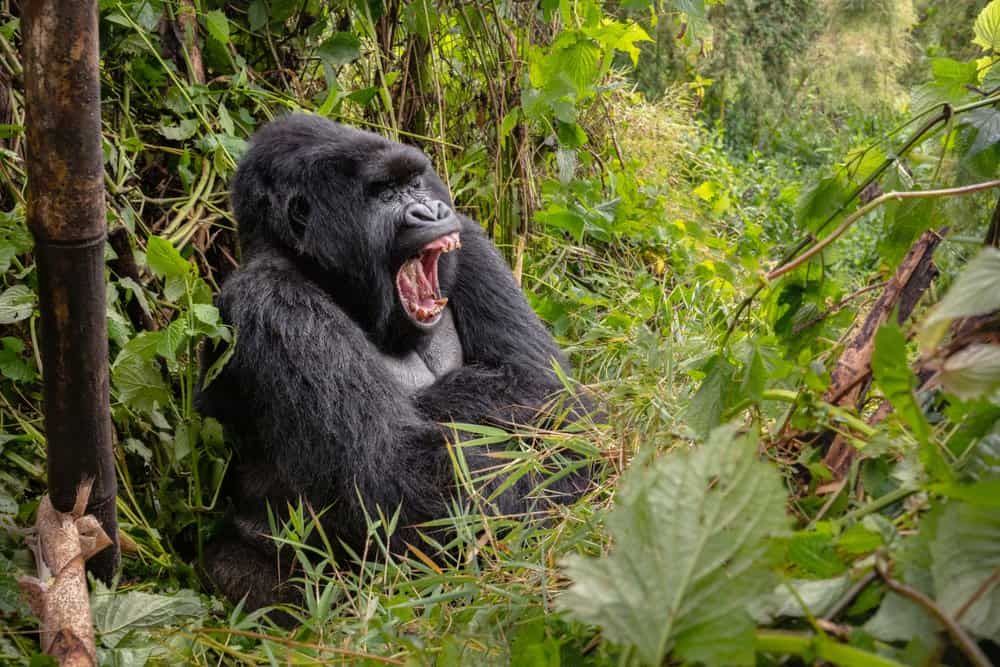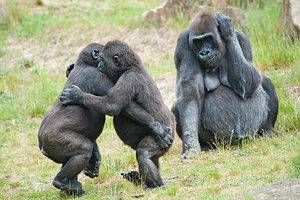There is something fascinating about gorillas. The gorilla is the largest of the great apes and is the closest living relative of man after bonobos and chimpanzees. We share 95% to 99% of our DNA with them! Additionally, they are capable of displaying a variety of emotions, such as sadness and laughter. These animals are also incredibly powerful – so you don’t want to mess with them! Over time, however, the gorilla population has been declining. Here is a look at how many gorillas are left in the world and what is being done to help them.
How Many Gorilla Species Are There?

The eastern gorilla and the western gorilla are the two species of gorillas in the world.
©PhotocechCZ/Shutterstock.com
There are two main species of gorillas in the world today. They are known as the western gorilla and the eastern gorilla. It is important to note that both of these species contain two subspecies. Mountain gorillas and Eastern lowland gorillas make up the eastern gorilla species. Western lowland gorillas and Cross River gorillas make up the western gorilla species. These two species differ only in their size and in how they communicate when they make noise. There is a tendency for the eastern gorilla to be bigger than the western gorilla. They have one thing in common; their natural habitats are being destroyed.
How Many Gorillas Are Left In The World?

The wild population of western gorillas is estimated at 316,000, and the population of eastern gorillas is estimated at 5,000.
©Sergey Uryadnikov/Shutterstock.com
It is unfortunate that gorillas are currently classified as one of the most critically endangered mammals. Over the past few decades, habitat loss, disease, and poaching have had an adverse impact on gorilla populations. As a result, the International Union for Conservation of Nature (IUCN) categorizes all gorilla species as endangered. So how many gorillas are left in the world? The number of western gorillas in the wild is estimated to be around 316,000, and the number of eastern gorillas is estimated to be 5,000.
Let’s take a look at the population numbers for each subspecies of gorilla:
- Eastern Lowland Gorillas: about 5,000
- Mountain Gorillas: about 1,000
- Western Lowland Gorillas: about 100,000
- Cross River Gorillas: about 200 to 300
There is no doubt that the gorilla population is in danger, as you can see from the numbers above. What are the biggest threats to gorillas? Let’s find out.
What Are The Biggest Threats To Gorillas?
Despite the fact that all four subspecies of gorillas are threatened, there are varying degrees of severity and types of threats depending on which area in which they live. A number of threats threaten wild gorilla populations, including hunting, illnesses, and habitat loss.
Hunting
The poaching of gorillas is one of the greatest threats to the population. Despite the fact that it is illegal to capture, kill, and consume gorillas, the illegal bushmeat trade has destroyed many of their habitats. According to the International Union for Conservation of Nature (IUCN), in addition to poachers, opportunistic hunters and traps aimed at other animals also target gorillas. Since new logging and mining roads have made it easier for poachers to access dense forests, poaching has been on the rise for lowland gorillas.
Diseases
According to the IUCN, disease is the second leading cause of declines among western lowland gorillas. Since the 1980s, the Ebola virus has specifically caused great ape deaths, often with 95% mortality rates. Cross River and eastern gorillas are also at risk of transmission of human diseases.
Deforestation and Habitat Loss
The loss of habitat is a threat to all great apes, including gorillas, though the severity of the threat varies from location to location. Plantations and industrial mining, for instance, destroy habitats directly and destroy forest habitats, which isolate gorilla populations. A majority of Cross River and eastern gorilla habitats are being lost due to human settlements, including illegal logging, farming expansion, and pasture expansion. According to reports, 59% of the Cross River gorilla habitat was lost between 1995 and 2010.
Where Can You Find Gorillas?
After understanding how habitat loss and poaching affect gorillas, let’s explore where they live. Tropical & subtropical forests dominate the gorilla’s natural habitat in Sub-Saharan Africa. Despite covering only a small percentage of Sub-Saharan Africa, gorillas live at varying elevations.
You can find these 4 subspecies in different areas:
- Mountain Gorillas: Forests with altitudes between 8,000 and 13,000 feet are home to Mountain Gorillas. Their habitat is the Virunga Mountains, which lie along the border between the Democratic Republic of Congo, Rwanda, and Uganda.
- Western Lowland Gorillas: This species is found throughout the region, from Cameroon to the Republic of Congo. Many of these gorillas live in swamps and the Republic of Congo, but some live deep inside the rain forests of Africa.
- Cross River Gorillas: About 3,000 square miles of forest and rainforest cover Cameroon and Nigeria, which is home to Cross River gorillas.
- Eastern Lowland Gorillas: This species of gorilla lives in the tropical rain forests of the Democratic Republic of Congo, where it thrives. During the last 50 years, the range of these animals has decreased from approximately 8,1000 square miles to about 4,600 square miles. It is estimated that only 13% of their original range is still occupied today.
Will Gorillas Go Extinct?

According to the International Union for Conservation of Nature (IUCN), all gorilla species are in danger of extinction.
©PhotocechCZ/Shutterstock.com
On the IUCN Red List, gorillas are listed as endangered or critically endangered. This leaves us wondering if gorillas will ever become extinct. This is a good question since it can seem like there are few options left for gorillas. The slow rate of reproduction of gorillas makes it difficult for them to recover from population declines.
Various threats like poaching, habitat loss, disease, and others are being addressed by conservationists. In addition to the Great Ape Survival Project, which is a collaboration between UNESCO and the United Nations Environment Programme, there is also the Gorilla Conservation Agreement, a treaty administered by UNEP under the Convention on Migratory Species. On 1 June 2008, the Gorilla Agreement became the first legally binding instrument addressing gorilla conservation exclusively. Through these conservation efforts, we hope to prevent a tragic end for the gorilla species.
The photo featured at the top of this post is © Krasnova Ekaterina/Shutterstock.com
Thank you for reading! Have some feedback for us? Contact the AZ Animals editorial team.






